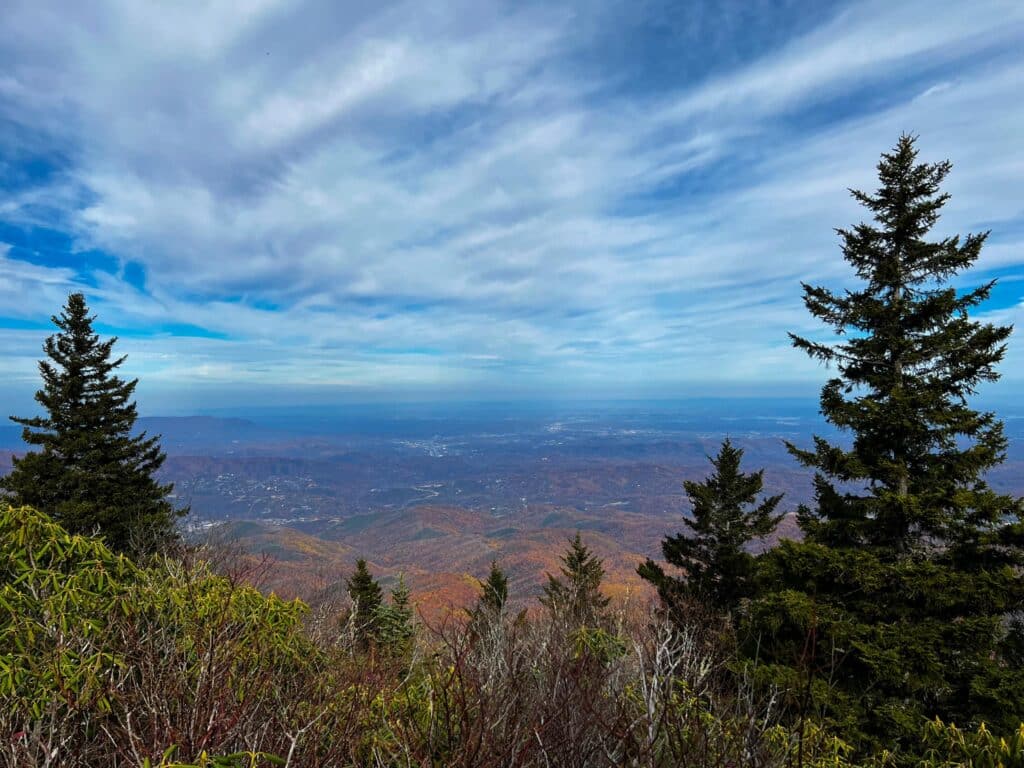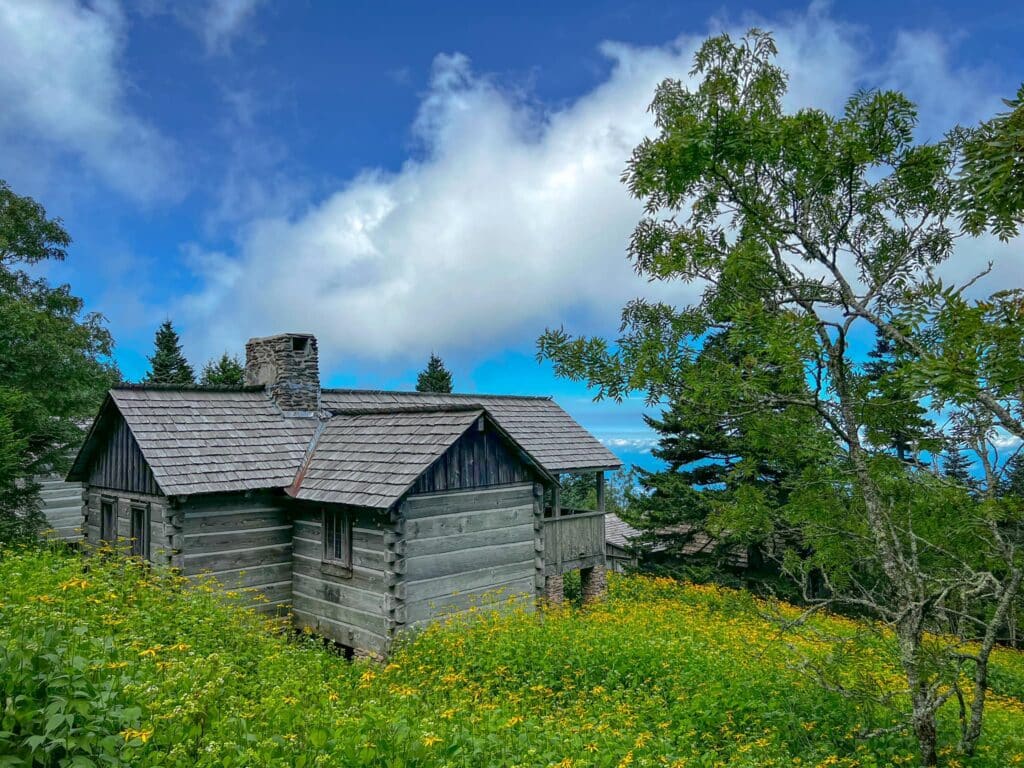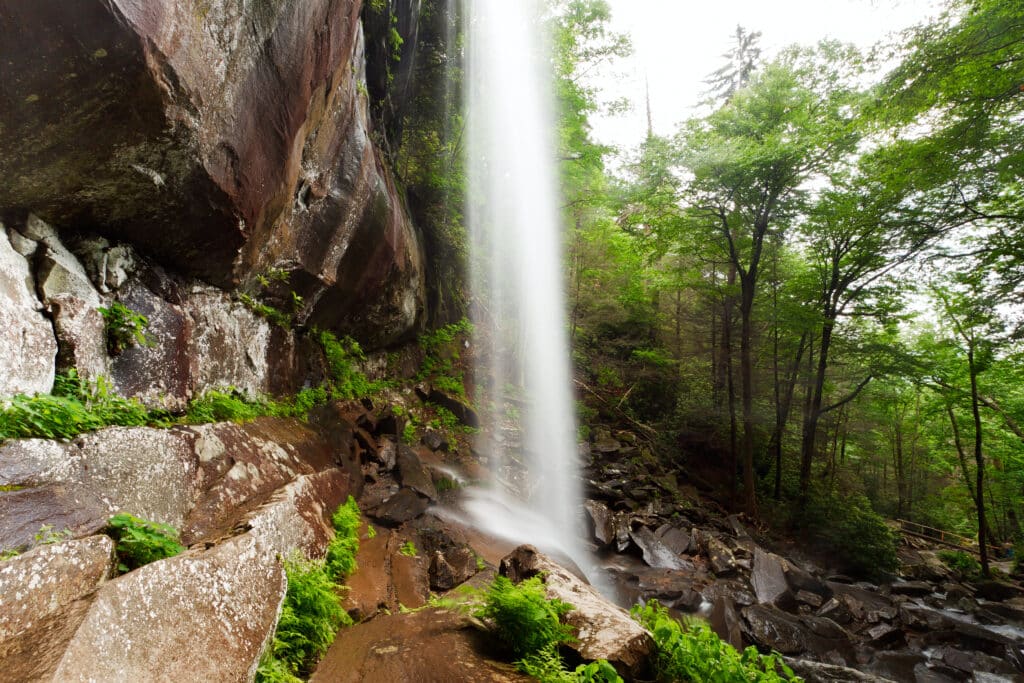In the heart of Great Smoky Mountains National Park lies a natural wonder: Mount LeConte. Enveloped in misty mornings and golden sunsets, this iconic peak stands 6,593 feet tall as the third-highest mountain in the Smokies. As hikers navigate the trails and relish the victories of reaching this summit, they develop a profound appreciation for the wilderness. It’s a communion with nature that every hiking enthusiast should undertake. This guide will take you on a virtual journey, capturing the essence of Mount LeConte and providing essential tips for your outdoor adventure.
A Guide To Hiking Mount LeConte
On November 9, 2023

Discovering Mount LeConte
Initially surveyed in the 1850s, Mount LeConte lay largely unexplored until the 1920s when Paul Adams, a member of the Great Smoky Mountain Conservation Association, embarked on a mission to unveil the region’s unparalleled beauty. The group’s ultimate aim was to establish the area as a national park.
In pursuit of this goal, Adams led an expedition up the mountain, accompanied by dignitaries from Washington. This journey offered them a firsthand experience of the rugged splendor that the Smoky Mountains held. In 1925, Adams, along with a group of dedicated hikers, erected the first permanent cabin atop Mount LeConte for the Great Smoky Mountains Conservation Association. Their initial overnight stay took place in a large tent, which would later evolve into the renowned LeConte Lodge, a beloved resort nestled near the peak’s summit.

The management of the lodge transitioned to Jack Huff in 1926, and over the years, it expanded and welcomed a diverse array of visitors, including Washington dignitaries and local conservationists, who flocked to LeConte to witness the mountain’s captivating views. This lodge played a pivotal role in the formation of Great Smoky Mountains National Park. As each visitor marveled at the awe-inspiring views from the top, the idea of establishing a national park to safeguard this remarkable landscape gained widespread support.
The expedition’s resounding success played a pivotal role in safeguarding Mount LeConte and its surroundings, leading to their inclusion in Great Smoky Mountains National Park, established in 1934. Since its formation, the park has become one of the largest protected reserves in the Eastern United States, with Mount LeConte standing as one of the most sought-after destinations within the Smokies, attracting thousands of hikers every year.
LeConte Lodge Today
Perched on an open glade just below the summit of Mt. LeConte at an elevation of about 6,400 feet, LeConte Lodge stands as a rare sanctuary. It is the only place in the eastern United States where visitors can sleep overnight at a summit in a permanent structure. Accessible solely via hiking trails, this rustic haven offers a retreat amid the stunning Smoky Mountains.
Open from March to November, the lodge treats guests to sweeping views of Smoky Mountain sunsets and sunrises. Accommodations include intimate one-room cabins and multi-room lodges, providing an authentic yet comfortable mountain experience for up to sixty guests.

Shared spaces like the dining hall and central lodge foster a sense of camaraderie among guests, where family-style hot meals, the warmth of propane heaters, and the soft glow of kerosene lanterns create an ambiance of simplicity. While lacking showers, the lodge compensates with the cozy comfort of warm Hudson Bay wool blankets, a cherished feature, especially as nighttime temperatures can drastically drop, even in the height of summer.

Supplies, including linens and food, reach the lodge via helicopter air drops and pack llamas. Even day visitors can soak in the lodge’s charm, exploring its gift shop offering exclusive items such as packed lunches and unique “I Hiked It” merchandise, available solely on the mountain.
Trail Options For Hiking Mount LeConte
Mount LeConte provides five distinct trails, each featuring its own set of unique landmarks. These trails vary in difficulty and length, allowing hikers the freedom to choose the route that best suits their preferences and capabilities. Let’s explore these trails in detail.
1. Alum Cave Trail
The Alum Cave Trail, spanning 5 miles, is the shortest and most popular hike to Mount LeConte, yet it’s also the steepest. Experienced hikers can conquer this trail in approximately 4 hours one way. The journey begins at a trailhead with two paved parking lots, located 9 miles south from Sugarlands Visitor Center on US HWY 441, where bathrooms are available. Crossing Walker Camp Prong and Alum Cave Creek on log bridges, hikers are led through an old-growth hardwood forest.
Notable landmarks on the way include Arch Rock, a formation from an icy era, just 1.4 miles in. The gap in the rock was formed from repeatedly freezing and thawing, and hikers must pass through the rock up a series of steps after a short footbridge over Styx Branch. This is a popular photo spot and can get crowded with many people.

2. Trillium Gap Trail
For those seeking a more relaxed hike or families with children, the Trillium Gap Trail offers a 6.7-mile moderately challenging ascent to Mount LeConte. Beginning at a small paved parking lot 4.5 miles south from Gatlinburg on Roaring Fork Motor Nature Trail, this trail, although not the shortest, boasts a gentler incline, making it the easiest among the options.
As you venture along, keep your eyes peeled – you might just encounter friendly llamas on this route. These adorable creatures are a common sight three days a week, delivering supplies up the mountain.

The first significant stop along Trillium Gap Trail, 1.5 miles in, is Grotto Falls, the park’s only walk-behind waterfall. Standing at 25 feet, the thundering water invites you to walk behind its curtain, creating a sensory experience that lingers long after the hike. This enchanting spot is best enjoyed amidst the blossoming embrace of spring, surrounded by spring beauties and trout lilies.
Many hikers opt for Grotto Falls as their turnaround point, creating a 3-mile round trip lasting 2 to 3 hours. Beyond the falls, the trail gradually thins out, offering a more serene atmosphere for those continuing their journey.
Approximately 1.5 miles past Grotto Falls, hikers reach the junction of Trillium Gap and the Brushy Mountain Trail. This juncture serves as a potential resting spot or turnaround point, marking the final major milestone before another 3.6 miles of the trek.
For a full Trillium Gap Trail experience, plan for a day-long adventure. The average hiker may spend 8 to 10 hours roundtrip, factoring in stops at Grotto Falls and scenic viewpoints. A sunrise start ensures reaching Mt. LeConte’s summit by lunchtime, allowing a safe return before nightfall. For an extended stay near the summit, consider booking a night at LeConte Lodge.
3. Boulevard/Appalachian Trail
The Boulevard/Appalachian Trail is the longest hike to Mount LeConte at 8.1 miles, so you’ll want to get an early start in the morning! Expect a rewarding 5.5 to 6-hour journey one way, tailored for moderate to experienced hikers.
This scenic odyssey commences at a spacious paved parking area at Newfound Gap, where US HWY 441 crosses the stateline. Starting at an elevation of 5,048 feet, the trail unveils breathtaking vistas, especially enchanting during the spring when vibrant wildflowers adorn the landscape. Around 2.7 miles from the trailhead, hikers encounter the Boulevard Trail junction. Continuing straight leads to Charlies Bunion, a rocky, treeless summit offering unmatched views of the Great Smoky Mountains.

Exclusive patches of grass of parnassus and purple monk’s hood adorn the trail in late summer. Additionally, a few exposed rock ledges higher up offer a thrilling experience, complete with hand cables for safety. Less than one-tenth of a mile after turning left onto The Boulevard Trail, hikers reach the junction for the Jump Off. Although not an official park trail, it is well-maintained and marked with a sign. We recommend saving this add-on hike for your descent. The Jump Off offers stunning views of Charlie’s Bunion and The Sawteeth. It’s a great spot for a picnic, adding an additional round trip mile to your hike.
Roughly two-tenths of a mile from the summit, a short spur trail appears, guiding hikers to Myrtle Point. This secluded spot, one of two locations on the mountain offering breathtaking panoramic views, invites travelers to revel in the majesty of the Great Smoky Mountains.
4. Rainbow Falls Trail
Embrace the legacy of the past on the historic Rainbow Falls Trail, believed to be the oldest route to the peak of Mt. LeConte. Braving significant elevation gains in a compact distance, this 6.7-mile path stands as one of the most strenuous trails to Mount LeConte. Amidst its challenges, the trail’s lush forests offer a shaded escape, providing respite from the elements.
The delightful sound of LeConte Creek accompanies your first half-mile, providing a serene backdrop to your hike. Cross three picturesque bridges before reaching the base of Rainbow Falls, approximately 2.7 miles from the trailhead.
Rainbow Falls, standing tall at 80 feet, earns its name from the vibrant rainbows that dance in the mist on sunny days. While visible from the trail, the falls beckon adventurers to approach cautiously through dense foliage for a closer look at the mesmerizing drop pool. Exercise care on the slippery rocks near the falls and relish the natural wonder of this enchanting spot.

For many hikers, the falls mark the end of the journey and serve as the point to head back. Most complete this round trip in under 5 hours, with some finishing in as little as 3. The challenging rocky terrain and substantial elevation gain make a few hours on the trail the perfect opportunity to appreciate nature, expend some energy, and work up an appetite for a hearty lunch.
If your goal is to reach the peak, be prepared for a much longer endeavor, which can take up to 10 hours to complete one way. After covering approximately 4 miles from the falls, you’ll merge onto the Bull Head Trail, a brief interlude on your way to the top. Around six miles from the Rainbow Falls trailhead, take a left at the Bull Head Trail junction. Continue for a little less than half a mile on the Alum Cave Trail before veering left onto the Trillium Gap Trail. Follow this path, and after about 6.7 miles from the trailhead, you’ll find yourself standing triumphantly at the summit, savoring the fruits of your adventurous spirit.
5. Bull Head Trail
Escape the bustling crowds and opt for the less-traveled Bull Head Trail, a 6.9-mile route meandering through wooded areas and open clearings, offering sweeping views of the mountains. The adventure begins at a trailhead featuring two paved parking lots, located 2.5 miles south of Gatlinburg on Cherokee Orchard Road. Unlike typical Smokies hikes that start on dirt paths with rocks and tree roots, the Bull Head Trail offers a unique beginning. Upon arrival at the trailhead’s parking lot, you’ll notice a gate blocking a gravel road. This trail commences by following the gravel road for 0.4 miles before veering to the left, inviting you to journey to Mount LeConte’s summit.

As you traverse the Bull Head Trail, intriguing features await your discovery. While passing rock cliff facings and a couple of caves, one of the trail’s standout attractions is The Pulpit, located roughly 3 miles into the hike. This man-made structure, a cairn constructed in the 1930s by the Civilian Conservation Corps, provided a means for hikers to rise above the rhododendron and behold the mountains to the east and northeast, including Brushy Mountain and the Greenbrier Valley.
While this vantage point once showcased breathtaking vistas, the landscape underwent a significant transformation after the 2016 wildfire. The fire cleared the trees and rhododendron, revealing expansive views that had been hidden for decades. Although the cairn retains its historical significance, modern hikers can now relish the area’s natural beauty in a fresh light, appreciating the unobstructed panoramas created by nature’s transformative force.
Beyond the initial mile, the trail gradually ascends, resembling a bull’s head from a distance. This unique topography ensures a tranquil and scenic journey to Mount LeConte’s summit, making your hike both memorable and visually captivating.
Spectacular Views From The Summit Of Mount LeConte
After the demanding climb, the summit of Mount LeConte stands as a testament to your hard work and perseverance. Anticipation mounts as you ascend, knowing that a world of breathtaking beauty lies just ahead. Imagine standing atop the crown of the Great Smoky Mountains, surrounded by an expansive panorama that stretches as far as the eye can see.

Upon reaching the summit, hikers are treated to a visual feast from not one, but four distinct viewpoints. Rising above 6,000 feet, West Point, High Top, Cliff Top, and Myrtle Point offer different perspectives of the surrounding landscape. Myrtle Point, in particular, stands out as the pinnacle for panoramic views, earning its reputation as the prime spot to witness a Smoky Mountain sunrise. Imagine the first light of day painting the sky in warm hues as the sun emerges, casting a golden glow over the misty valleys below.
On the opposite end, Cliff Top takes the spotlight as the ultimate locale to capture a Smoky Mountain sunset. Picture the sun gracefully setting behind the peaks, casting a mesmerizing orange and pink glow across the horizon. It’s a spectacle that paints the mountains in hues of fire, creating a scene that will be etched in your memory long after you descend.
For those seeking the most enchanting moments, plan your visit to align with sunrise or sunset. These golden hours transform the already breathtaking views into something truly extraordinary.
Tips For Hiking Mount LeConte
Plan Ahead:
Research the trail options, check weather forecasts, and make reservations for accommodations well in advance, especially if you plan to stay at LeConte Lodge.
Start Early:
Begin your hike early in the day to avoid the crowds and have ample time to complete the hike before dark.
Hiking Gear:
Pack appropriately for the trail. Sturdy hiking boots, layered clothing, rain gear, and a backpack with essentials like water, snacks, a first-aid kit, and navigation tools are crucial.
Follow Leave No Trace Principle:
Respect the environment by staying on the trail, disposing of waste properly, and not disturbing wildlife. Leave only footprints.
Know Your Limits:
Hiking Mount LeConte can be challenging. Listen to your body, take breaks, and turn back if you feel overwhelmed.
Wildlife Awareness:
Be alert to the possibility of wildlife encounters. Maintain a safe distance, do not feed animals, and secure your food to avoid attracting them.
Trail Etiquette:
Yield the trail to uphill hikers, and be courteous to fellow hikers. Keep noise levels to a minimum to preserve the tranquility of the wilderness.
Photography Tips:
Capture the beauty of Mount LeConte but avoid disturbing the natural habitat. Look for unique angles and lighting for stunning photos.
Emergency Preparedness: Inform someone about your hiking plans, estimated return time, and location. Carry a whistle and a fully charged cell phone for emergencies. Consider bringing a GPS device or smartphone with a GPS app in case you need assistance.





